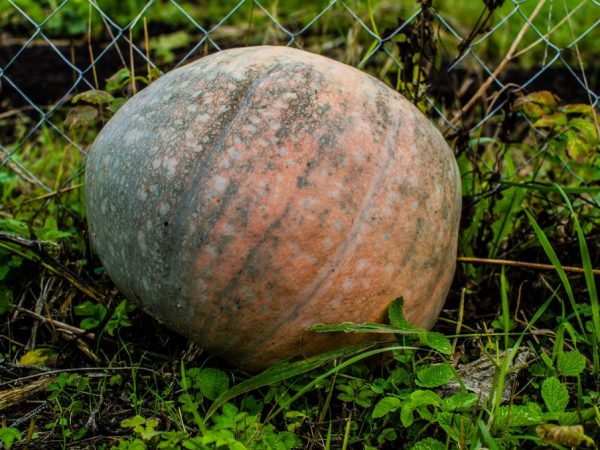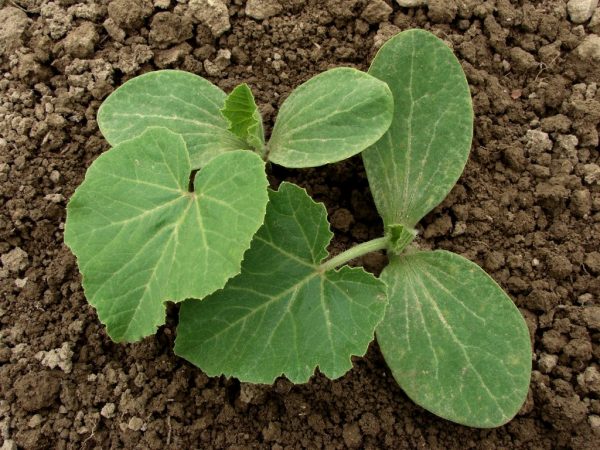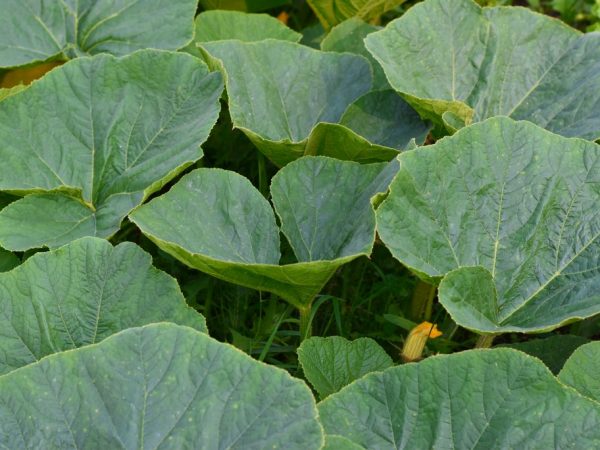Marble gourd
Marble pumpkin is a special variety that, according to its description, differs from the classic pumpkin varieties in the color of the peel, juiciness and sweetness. Bred by the Research Institute of Vegetable Economy in Krasnodar. In 1975, they began to cultivate it in the North Caucasus region.

Marble gourd
Description of the variety
The vegetable belongs to the nutmeg varieties with specific taste characteristics and a high content of carotene and sugar. The marble gourd has long lashes covered with unbroken green leaf blades.
Description of the variety:
- has a flattened shape;
- the surface is wrinkled, divided into characteristic segments;
- the color of the peel is gray, in some cases it is dark gray with a green tint, it has light gray specks and stripes passing between the segments;
- large-fruited species, the average weight of fruits is 4.5-5 kg, however, there are some specimens reaching 10 kg;
- the pulp has a carrot color, a slight smell of nutmeg, it is dense in structure, according to the description of taste - tender, juicy and sweet, the length of the seeds is 1-3 cm.
The marble pumpkin belongs to the mid-season. The ripening period, from the moment of emergence to the first harvest, lasts 130-140 days.
Yield indicators - 1.6-3 kg per 1 m².
Benefits
The description of the vegetable indicates that the fruit does not crack. Vegetables can be stored for a long time. The vegetable is resistant to white rot, which often appears on other pumpkins. It is eaten both raw and processed. In the process of heat treatment, it does not lose its gastronomic qualities, its structure becomes similar to mashed potatoes with a pleasant nutmeg aftertaste.
disadvantages
The description of the marble gourd indicates that it requires more careful care when grown in open soil:
- does not tolerate shading;
- requires good nutrition;
- needs a long day of light;
- does not tolerate low temperatures;
- does not tolerate drought.
If the rules of cultivation are violated, the fruits develop with a noticeable delay, begin to shrink, the crop partially rots, and undeveloped seed pods appear in ripe vegetables.
Growing features
The marbled gourd variety is traditionally grown in open ground, so it is suitable for southern areas with warm climates. When cultivated in cool climatic conditions, the vegetable loses its sweetness, does not have time to ripen in a short summer.
Preparing the landing site

The bed should be formed in a sunny place.
The bed is formed in an area illuminated by the sun, closed from direct wind streams. The preparation of the ridges is already being done in the fall. The earth is dug up and at the same time humus is introduced at the rate of 3-4 kg per 1 m².
Growing the marble variety requires highly fertile soil without increased acidity.
In the spring, before planting seeds, fertilizers containing potassium and phosphorus are added to the ground.Wood ash or lime is added to acidified soils.
Seed preparation
pumpkin seeds are prepared for planting by pretreatment:
- heated for 12 hours at a temperature of 40 ° C;
- for 12 hours soaked in an ash solution at room temperature (1 liter of ash per 2 liters of water);
- dried.
Landing
Usually, the seeds of the marble variety are planted without prior germination. Seeds prepared for planting are placed in the ground when it warms up to a temperature of 13 ° C and above.
Planting stages:
- in the soil layer at a distance of 0.5 m, make wide (about 0.3 m) holes 5-6 cm deep;
- each hole is watered with 2 liters of hot water;
- after complete absorption of water, 2-3 seeds are placed in the hole;
- from above, the seeds are covered with earth or mixed in equal proportions with humus with dry mineral dressing.
Heat-loving butternut squash at the initial stage after planting is protected from possible frost by covering with film or agrofibre. The material is removed when the weather is stable and warm.
Further care
Further care for the muscat species includes thinning, watering, weeding and feeding.
Thinning
When 3 planting leaves appear on the plants, they are thinned out, leaving only one of the 2-3 planted shoots, the strongest, the rest are removed. At the same time, they are not pulled out to avoid damage to the root system, but are cut off.
Watering

The variety loves moisture
The marbled look loves moisture, therefore, after planting, the seeds are watered every day until sprouts appear. The grown pumpkin needs watering as the soil dries up, while the volume of water increases to 5 liters per 1 bush. Water is poured strictly under the roots, and before the procedure, the soil is loosened without touching the root system.
Weeding
Removing weeds directly affects the size of future fruits. Weeds take up a large proportion of the mineral nutrition, damaging the developing young shoots. Weeding also clears the space between vegetables and increases the air flow to the roots.
Top dressing
For the full development of the variety, fertilizing with fertilizers is important, because he loves fertile land. Top dressing is done 3 weeks after planting:
- initially vegetables are fertilized with solutions on chicken manure or mullein;
- at the stage of the formation of inflorescences and the appearance of fruits, they use a similar feeding, adding wood ash and mineral complexes to it.
Soil soils poor in minerals are fed several times a month.
Harvesting and storage
The harvest of a mid-season nutmeg variety usually falls at the end of summer, and in unfavorable climatic regions it does not begin until autumn. Before harvesting vegetables, perform certain actions:
- wait for the pumpkin foliage to dry completely;
- choose a warm and clear day for picking vegetables;
- when cutting the stalks, leave a tail at least 4 cm long.
Whole and undamaged vegetables are selected for storage. To preserve vegetables, choose a dry room where the temperature does not drop below 12 ° C. If these conditions are met, the vegetable retains its external attractiveness and gastronomic value for 1 year.
Conclusion
Marble pumpkin belongs to mid-season nutmeg varieties. Differs in a green-gray skin, dissected in stripes. It is grown in open soil in regions with warm climatic conditions, where frosts begin no earlier than October.

